Humen Zhong
Qwen2.5-VL Technical Report
Feb 19, 2025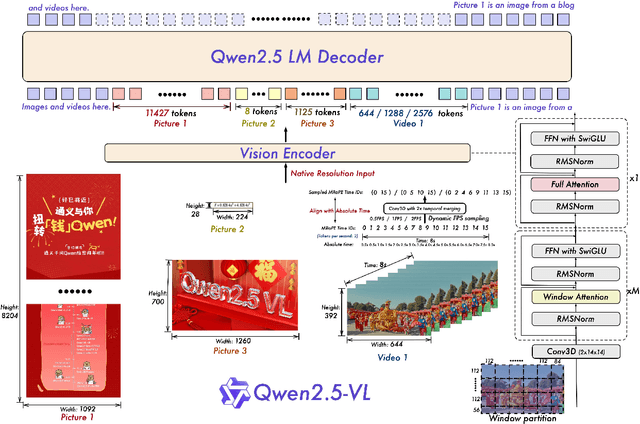
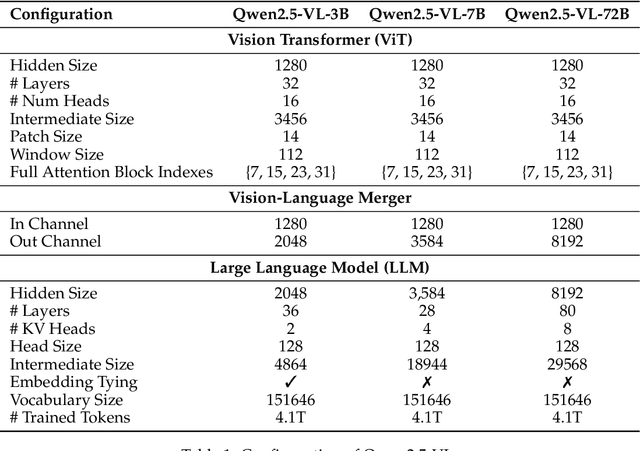

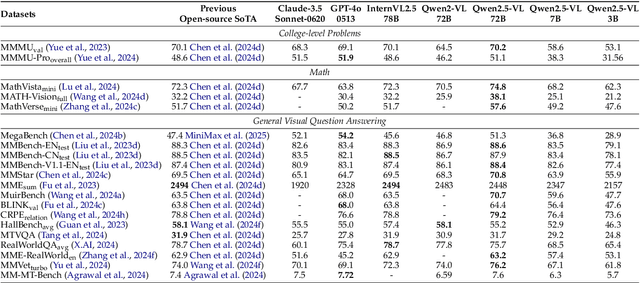
Abstract:We introduce Qwen2.5-VL, the latest flagship model of Qwen vision-language series, which demonstrates significant advancements in both foundational capabilities and innovative functionalities. Qwen2.5-VL achieves a major leap forward in understanding and interacting with the world through enhanced visual recognition, precise object localization, robust document parsing, and long-video comprehension. A standout feature of Qwen2.5-VL is its ability to localize objects using bounding boxes or points accurately. It provides robust structured data extraction from invoices, forms, and tables, as well as detailed analysis of charts, diagrams, and layouts. To handle complex inputs, Qwen2.5-VL introduces dynamic resolution processing and absolute time encoding, enabling it to process images of varying sizes and videos of extended durations (up to hours) with second-level event localization. This allows the model to natively perceive spatial scales and temporal dynamics without relying on traditional normalization techniques. By training a native dynamic-resolution Vision Transformer (ViT) from scratch and incorporating Window Attention, we reduce computational overhead while maintaining native resolution. As a result, Qwen2.5-VL excels not only in static image and document understanding but also as an interactive visual agent capable of reasoning, tool usage, and task execution in real-world scenarios such as operating computers and mobile devices. Qwen2.5-VL is available in three sizes, addressing diverse use cases from edge AI to high-performance computing. The flagship Qwen2.5-VL-72B model matches state-of-the-art models like GPT-4o and Claude 3.5 Sonnet, particularly excelling in document and diagram understanding. Additionally, Qwen2.5-VL maintains robust linguistic performance, preserving the core language competencies of the Qwen2.5 LLM.
CC-OCR: A Comprehensive and Challenging OCR Benchmark for Evaluating Large Multimodal Models in Literacy
Dec 03, 2024Abstract:Large Multimodal Models (LMMs) have demonstrated impressive performance on recognizing document images with natural language instructions. However, it remains unclear to what extent capabilities in literacy with rich structure and fine-grained visual challenges. The current landscape lacks a comprehensive benchmark to effectively measure the literate capabilities of LMMs. Existing benchmarks are often limited by narrow scenarios and specified tasks. To this end, we introduce CC-OCR, a comprehensive benchmark that possess a diverse range of scenarios, tasks, and challenges. CC-OCR comprises four OCR-centric tracks: multi-scene text reading, multilingual text reading, document parsing, and key information extraction. It includes 39 subsets with 7,058 full annotated images, of which 41% are sourced from real applications, being released for the first time. Furthermore, we evaluate nine prominent LMMs and reveal both the strengths and weaknesses of these models, particularly in text grounding, multi-orientation, and hallucination of repetition. CC-OCR aims to comprehensively evaluate the capabilities of LMMs on OCR-centered tasks, driving advancement in LMMs.
VL-Reader: Vision and Language Reconstructor is an Effective Scene Text Recognizer
Sep 18, 2024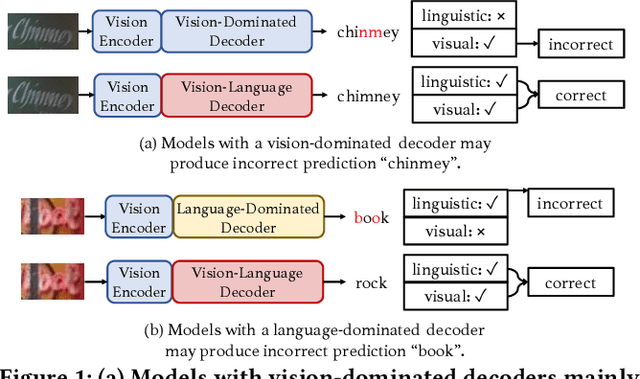
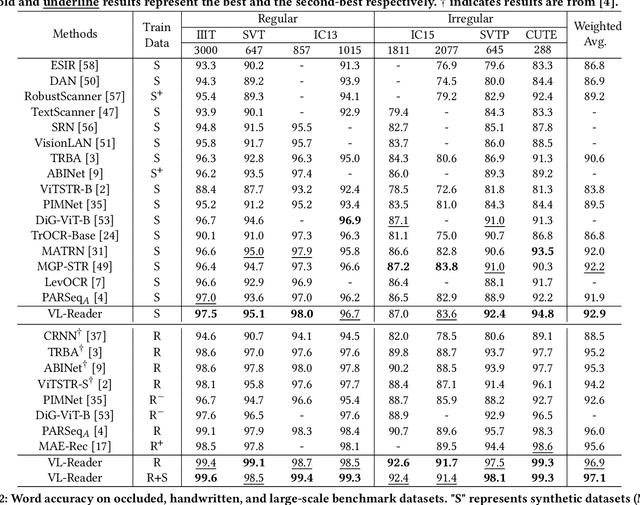

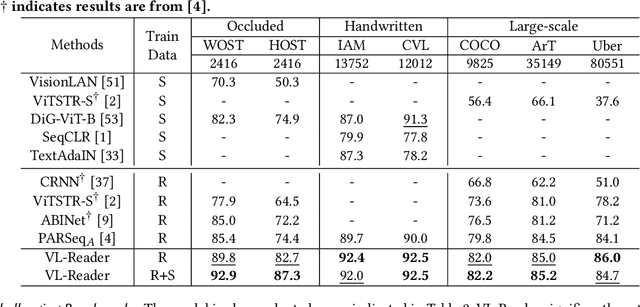
Abstract:Text recognition is an inherent integration of vision and language, encompassing the visual texture in stroke patterns and the semantic context among the character sequences. Towards advanced text recognition, there are three key challenges: (1) an encoder capable of representing the visual and semantic distributions; (2) a decoder that ensures the alignment between vision and semantics; and (3) consistency in the framework during pre-training, if it exists, and fine-tuning. Inspired by masked autoencoding, a successful pre-training strategy in both vision and language, we propose an innovative scene text recognition approach, named VL-Reader. The novelty of the VL-Reader lies in the pervasive interplay between vision and language throughout the entire process. Concretely, we first introduce a Masked Visual-Linguistic Reconstruction (MVLR) objective, which aims at simultaneously modeling visual and linguistic information. Then, we design a Masked Visual-Linguistic Decoder (MVLD) to further leverage masked vision-language context and achieve bi-modal feature interaction. The architecture of VL-Reader maintains consistency from pre-training to fine-tuning. In the pre-training stage, VL-Reader reconstructs both masked visual and text tokens, while in the fine-tuning stage, the network degrades to reconstruct all characters from an image without any masked regions. VL-reader achieves an average accuracy of 97.1% on six typical datasets, surpassing the SOTA by 1.1%. The improvement was even more significant on challenging datasets. The results demonstrate that vision and language reconstructor can serve as an effective scene text recognizer.
Platypus: A Generalized Specialist Model for Reading Text in Various Forms
Aug 27, 2024



Abstract:Reading text from images (either natural scenes or documents) has been a long-standing research topic for decades, due to the high technical challenge and wide application range. Previously, individual specialist models are developed to tackle the sub-tasks of text reading (e.g., scene text recognition, handwritten text recognition and mathematical expression recognition). However, such specialist models usually cannot effectively generalize across different sub-tasks. Recently, generalist models (such as GPT-4V), trained on tremendous data in a unified way, have shown enormous potential in reading text in various scenarios, but with the drawbacks of limited accuracy and low efficiency. In this work, we propose Platypus, a generalized specialist model for text reading. Specifically, Platypus combines the best of both worlds: being able to recognize text of various forms with a single unified architecture, while achieving excellent accuracy and high efficiency. To better exploit the advantage of Platypus, we also construct a text reading dataset (called Worms), the images of which are curated from previous datasets and partially re-labeled. Experiments on standard benchmarks demonstrate the effectiveness and superiority of the proposed Platypus model. Model and data will be made publicly available at https://github.com/AlibabaResearch/AdvancedLiterateMachinery/tree/main/OCR/Platypus.
Modeling Entities as Semantic Points for Visual Information Extraction in the Wild
Mar 29, 2023



Abstract:Recently, Visual Information Extraction (VIE) has been becoming increasingly important in both the academia and industry, due to the wide range of real-world applications. Previously, numerous works have been proposed to tackle this problem. However, the benchmarks used to assess these methods are relatively plain, i.e., scenarios with real-world complexity are not fully represented in these benchmarks. As the first contribution of this work, we curate and release a new dataset for VIE, in which the document images are much more challenging in that they are taken from real applications, and difficulties such as blur, partial occlusion, and printing shift are quite common. All these factors may lead to failures in information extraction. Therefore, as the second contribution, we explore an alternative approach to precisely and robustly extract key information from document images under such tough conditions. Specifically, in contrast to previous methods, which usually either incorporate visual information into a multi-modal architecture or train text spotting and information extraction in an end-to-end fashion, we explicitly model entities as semantic points, i.e., center points of entities are enriched with semantic information describing the attributes and relationships of different entities, which could largely benefit entity labeling and linking. Extensive experiments on standard benchmarks in this field as well as the proposed dataset demonstrate that the proposed method can achieve significantly enhanced performance on entity labeling and linking, compared with previous state-of-the-art models. Dataset is available at https://www.modelscope.cn/datasets/damo/SIBR/summary.
ARTS: Eliminating Inconsistency between Text Detection and Recognition with Auto-Rectification Text Spotter
Oct 20, 2021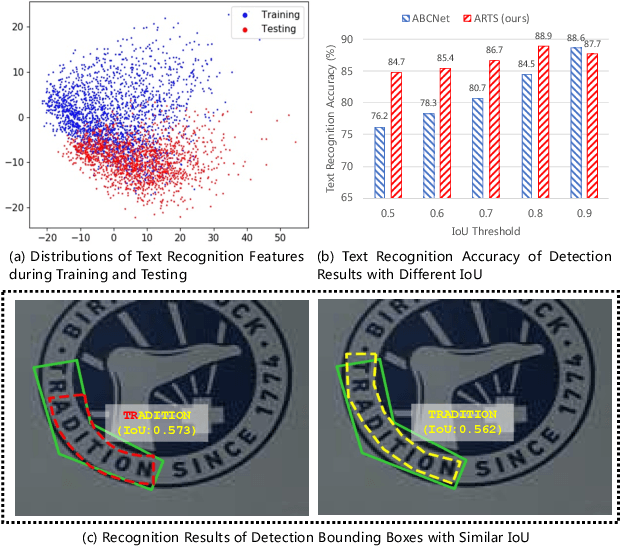
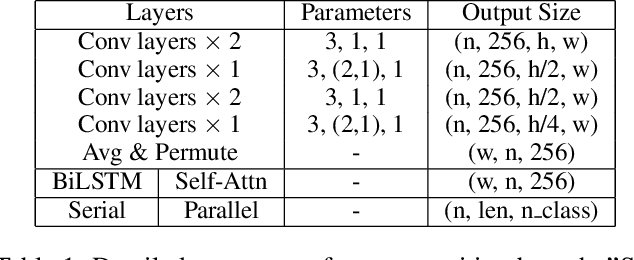
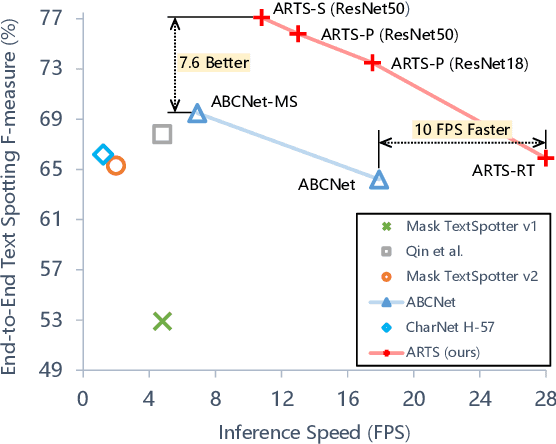
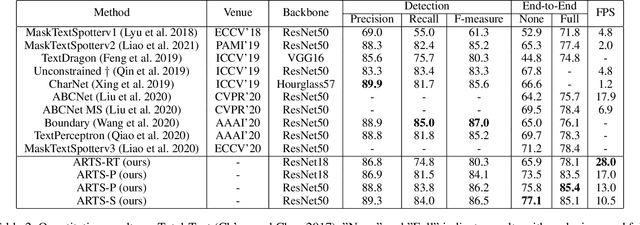
Abstract:Recent approaches for end-to-end text spotting have achieved promising results. However, most of the current spotters were plagued by the inconsistency problem between text detection and recognition. In this work, we introduce and prove the existence of the inconsistency problem and analyze it from two aspects: (1) inconsistency of text recognition features between training and testing, and (2) inconsistency of optimization targets between text detection and recognition. To solve the aforementioned issues, we propose a differentiable Auto-Rectification Module (ARM) together with a new training strategy to enable propagating recognition loss back into detection branch, so that our detection branch can be jointly optimized by detection and recognition targets, which largely alleviates the inconsistency problem between text detection and recognition. Based on these designs, we present a simple yet robust end-to-end text spotting framework, termed Auto-Rectification Text Spotter (ARTS), to detect and recognize arbitrarily-shaped text in natural scenes. Extensive experiments demonstrate the superiority of our method. In particular, our ARTS-S achieves 77.1% end-to-end text spotting F-measure on Total-Text at a competitive speed of 10.5 FPS, which significantly outperforms previous methods in both accuracy and inference speed.
MOST: A Multi-Oriented Scene Text Detector with Localization Refinement
Apr 05, 2021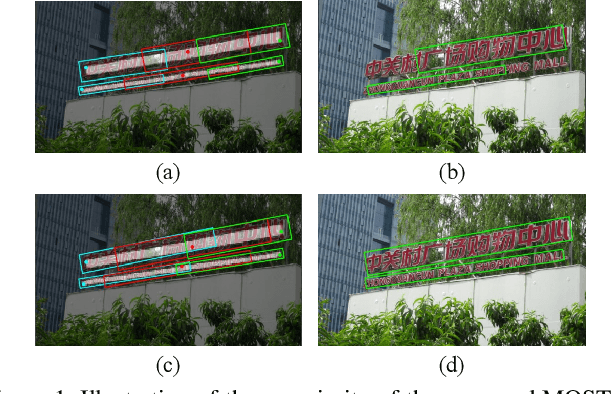
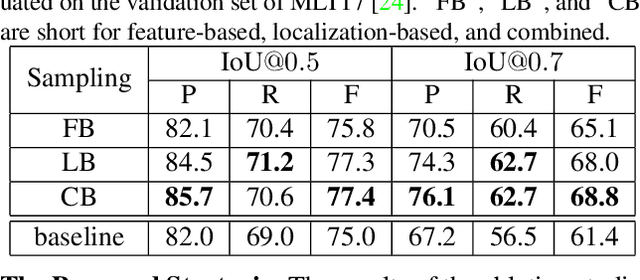
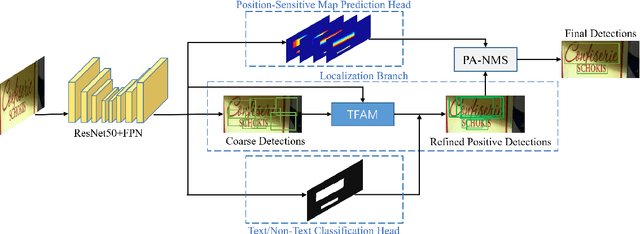

Abstract:Over the past few years, the field of scene text detection has progressed rapidly that modern text detectors are able to hunt text in various challenging scenarios. However, they might still fall short when handling text instances of extreme aspect ratios and varying scales. To tackle such difficulties, we propose in this paper a new algorithm for scene text detection, which puts forward a set of strategies to significantly improve the quality of text localization. Specifically, a Text Feature Alignment Module (TFAM) is proposed to dynamically adjust the receptive fields of features based on initial raw detections; a Position-Aware Non-Maximum Suppression (PA-NMS) module is devised to selectively concentrate on reliable raw detections and exclude unreliable ones; besides, we propose an Instance-wise IoU loss for balanced training to deal with text instances of different scales. An extensive ablation study demonstrates the effectiveness and superiority of the proposed strategies. The resulting text detection system, which integrates the proposed strategies with a leading scene text detector EAST, achieves state-of-the-art or competitive performance on various standard benchmarks for text detection while keeping a fast running speed.
 Add to Chrome
Add to Chrome Add to Firefox
Add to Firefox Add to Edge
Add to Edge